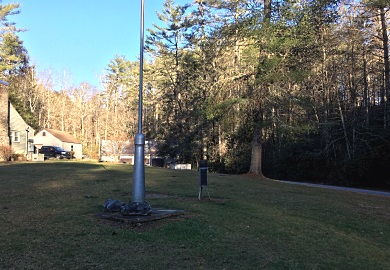If you are seeing this, then your internet browser is Microsoft Internet Explorer and you are running in Compatibility mode. You will not be able to view the application with this browser and these settings.
Please remove "SC.GOV" from your compatibility view listings using your settings in the Internet Explorer options.
SCDNR News
Above Average Rainfall Breaks Annual State Record
January 16, 2019

The rain gauge located at Walhalla State Fish Hatchery in Jocassee that observed the wettest year in the area.
If it seemed like you were pulling out the raincoat and umbrella way too often during the 2018 Holiday season, you were correct. Preliminary data for South Carolina indicates December was the second wettest out of the 124-year record, with a statewide average rainfall of 7.67 inches which is almost double the normal rainfall of 3.56 inches for December.
According to Melissa Griffin, South Carolina’s Assistant State Climatologist for Service, the rainfall during December was so extreme it pushed the annual rainfall total at Jocassee to a level never recorded in South Carolina.
The Jocassee 8 WNW National Weather Service Cooperative Weather Station located at the Walhalla Fish Hatchery received a soaking 17.25 inches of rain in December 2018, pushing their annual total to a record-breaking 123.45 inches. This value would surpass the previous record of 119.16 inches set at Hogback Mountain in 1979.
While it could be several months before this value is official, the S.C. State Climatology Office says there is supporting evidence that 123.45 inches will be the new South Carolina annual rainfall record.
S.C. State Climatologist Hope Mizzell, explained, “A nearby USGS automated rain gauge at Slicking Mountain near Rocky Bottom logged a total of 118.2 inches and a NWS Cooperative Weather station at Caesars Head recorded 115.10 inches. These values are relatively close in proximity and in value which supports that the 123.45 inches is a valid measurement. We still have to complete a site inspection and convene a 5-person State Climate Extremes Committee (SCEC) that will evaluate the validity of the observation and make a recommendation to the National Centers for Environmental Information to officially sanction the value. The Committee consists of State and Federal agencies and due to the federal government shutdown the length of time it may take to review and confirm the observation is unknown.”
Griffin commented, “The 123.45 inches is a staggering 37.69 inches above their normal annual rainfall. It wasn’t one big event or even one big month, but an overall pattern of much above normal rainfall throughout the year. By February 2018 they had already accumulated over 21 inches of rain. The 17.74 inches received in May did set a new record for their wettest May. They also had excessive rainfall in July, August, November and December.
Jocassee 8 WNW, SC 1990 -2018
| Jan | Feb | Mar | Apr | May | Jun | Jul | Aug | Sep | Oct | Nov | Dec | Annual | |
|---|---|---|---|---|---|---|---|---|---|---|---|---|---|
| 2018 | 10.16 | 11.71 | 5.05 | 9.63 | 17.74 | 3.72 | 12.12 | 12.87 | 4.53 | 8.52 | 10.15 | 17.25 | 123.45 |
| Mean | 7.42 | 5.92 | 7.20 | 6.21 | 6.45 | 7.08 | 8.09 | 9.06 | 7.90 | 6.05 | 7.01 | 8.14 | 85.76 |
| Max | 20.23 1998 | 13.29 1998 | 16.68 2011 | 12.47 1998 | 17.74 2018 | 25.15 2005 | 24.75 2013 | 21.15 1994 | 30.77 2004 | 15.76 2017 | 17.92 1992 | 20.33 2015 | 123.45 2018 |
| Min | 2.29 2004 | 1.67 2017 | 0.82 2006 | 1.46 2001 | 1.91 2006 | 1.00 1990 | 2.90 2002 | 1.73 1993 | 1.84 2008 | 0.00 2000 | 0.78 2012 | 3.77 2010 | 49.16 2007 |
The Jocassee 8 WNW station is located at the South Carolina Department of Natural Resources’ Walhalla Fish Hatchery. The staff, which includes Scott Poore, Robby Lowery, Cory Guinn and Damon Wilber, takes daily temperature and rainfall observations.
Scott Poore, manager of the Hatchery, said, “As the year progressed, staff understood that it was an abnormal year simply by the flows we experienced within the hatchery, as well as the observations of the nearby streams maintaining nearly consistent water levels throughout the year. In years past, we have often had to rely on the remnants of a tropical system to bring depleted stream levels back to more normal conditions, but 2018 allowed us to maintain fish production without the fear of the stressors brought about by drought conditions.”
The abundant rainfall did create challenges for the team by increasing the sediment loads entering the tanks and raceway, but staff said they certainly prefer adequate rainfall rather than drought because it is much easier to keep fish alive and healthy.
The Jocassee station is one of the over 8,000 National Weather Service Cooperative (COOP) Weather stations that provide daily observations of temperature and precipitation across the United States. The measurements provided by these citizen volunteers have provided the data that serve as the backbone of the nation's climate record.
The State Climate Office would like to thank the dedicated team at the hatchery and extend their appreciation to all of the citizens who participate in the COOP network and provide weather observations through many of the citizen science programs across the United States.



